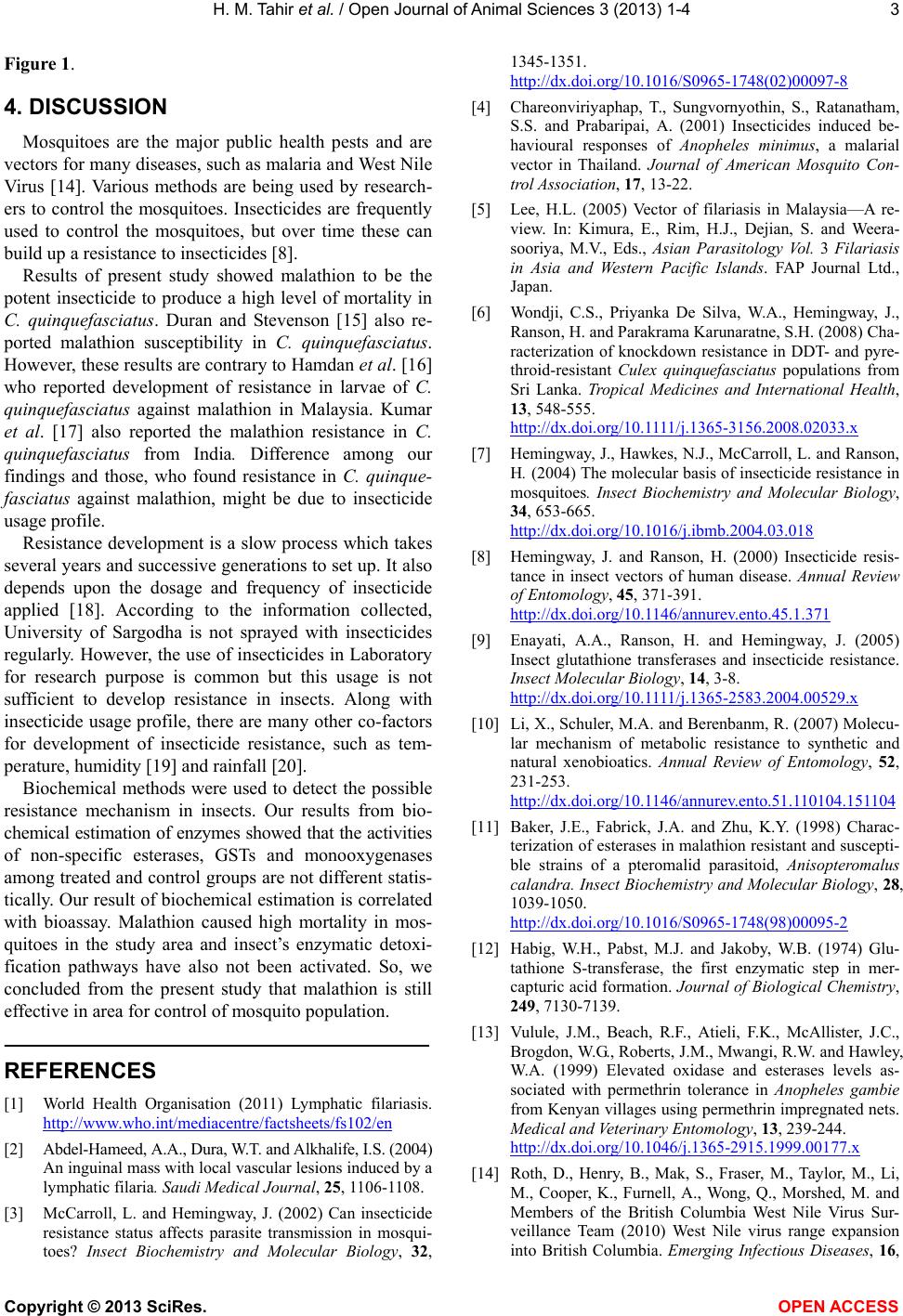
H. M. Tahir et al. / Open Journal of Animal Sciences 3 (2013) 1-4 3
Figure 1.
4. DISCUSSION
Mosquitoes are the major public health pests and are
vectors for many diseases, such as malaria and West Nile
Virus [14]. Various methods are being used by research-
ers to control the mosquitoes. Insecticides are frequently
used to control the mosquitoes, but over time these can
build up a resistance to insecticides [8].
Results of present study showed malathion to be the
potent insecticide to produce a high level of mortality in
C. quinquefasciatus. Duran and Stevenson [15] also re-
ported malathion susceptibility in C. quinquefasciatus.
However, these results are contrary to Hamdan et al. [16]
who reported development of resistance in larvae of C.
quinquefasciatus against malathion in Malaysia. Kumar
et al. [17] also reported the malathion resistance in C.
quinquefasciatus from India. Difference among our
findings and those, who found resistance in C. quinque-
fasciatus against malathion, might be due to insecticide
usage profile.
Resistance development is a slow process which takes
several years and successive generations to set up. It also
depends upon the dosage and frequency of insecticide
applied [18]. According to the information collected,
University of Sargodha is not sprayed with insecticides
regularly. However, the use of insecticides in Laboratory
for research purpose is common but this usage is not
sufficient to develop resistance in insects. Along with
insecticide usage profile, there are many other co-factors
for development of insecticide resistance, such as tem-
perature, humidity [19] and rainfall [20].
Biochemical methods were used to detect the possible
resistance mechanism in insects. Our results from bio-
chemical estimation of enzymes showed that the activities
of non-specific esterases, GSTs and monooxygenases
among treated and control groups are not different statis-
tically. Our result of biochemical estimation is correlated
with bioassay. Malathion caused high mortality in mos-
quitoes in the study area and insect’s enzymatic detoxi-
fication pathways have also not been activated. So, we
concluded from the present study that malathion is still
effective in area for control of mosquito population.
REFERENCES
[1] World Health Organisation (2011) Lymphatic filariasis.
http://www.who.int/mediacentre/factsheets/fs102/en
[2] Abdel-Hameed, A.A., Dura, W.T. and Alkhalife, I.S. (2004)
An inguinal mass with local vascular lesions induced by a
lymphatic filaria. Saudi Medical Journal, 25, 1106-1108.
[3] McCarroll, L. and Hemingway, J. (2002) Can insecticide
resistance status affects parasite transmission in mosqui-
toes? Insect Biochemistry and Molecular Biology, 32,
1345-1351.
http://dx.doi.org/10.1016/S0965-1748(02)00097-8
[4] Chareonviriyaphap, T., Sungvornyothin, S., Ratanatham,
S.S. and Prabaripai, A. (2001) Insecticides induced be-
havioural responses of Anopheles minimus, a malarial
vector in Thailand. Journal of American Mosquito Con-
trol Association, 17, 13-22.
[5] Lee, H.L. (2005) Vector of filariasis in Malaysia—A re-
view. In: Kimura, E., Rim, H.J., Dejian, S. and Weera-
sooriya, M.V., Eds., Asian Parasitology Vol. 3 Filariasis
in Asia and Western Pacific Islands. FAP Journal Ltd.,
Japan.
[6] Wondji, C.S., Priyanka De Silva, W.A., Hemingway, J.,
Ranson, H. and Parakrama Karunaratne, S.H. (2008) Cha-
racterization of knockdown resistance in DDT- and pyre-
throid-resistant Culex quinquefasciatus populations from
Sri Lanka. Tropical Medicines and International Health,
13, 548-555.
http://dx.doi.org/10.1111/j.1365-3156.2008.02033.x
[7] Hemingway, J., Hawkes, N.J., McCarroll, L. and Ranson,
H. (2004) The molecular basis of insecticide resistance in
mosquitoes. Insect Biochemistry and Molecular Biology,
34, 653-665.
http://dx.doi.org/10.1016/j.ibmb.2004.03.018
[8] Hemingway, J. and Ranson, H. (2000) Insecticide resis-
tance in insect vectors of human disease. Annual Review
of Entomology, 45, 371-391.
http://dx.doi.org/10.1146/annurev.ento.45.1.371
[9] Enayati, A.A., Ranson, H. and Hemingway, J. (2005)
Insect glutathione transferases and insecticide resistance.
Insect Molecular Biology, 14, 3-8.
http://dx.doi.org/10.1111/j.1365-2583.2004.00529.x
[10] Li, X., Schuler, M.A. and Berenbanm, R. (2007) Molecu-
lar mechanism of metabolic resistance to synthetic and
natural xenobioatics. Annual Review of Entomology, 52,
231-253.
http://dx.doi.org/10.1146/annurev.ento.51.110104.151104
[11] Baker, J.E., Fabrick, J.A. and Zhu, K.Y. (1998) Charac-
terization of esterases in malathion resistant and suscepti-
ble strains of a pteromalid parasitoid, Anisopteromalus
calandra. Insect Biochemistry and Molecular Biology, 28,
1039-1050.
http://dx.doi.org/10.1016/S0965-1748(98)00095-2
[12] Habig, W.H., Pabst, M.J. and Jakoby, W.B. (1974) Glu-
tathione S-transferase, the first enzymatic step in mer-
capturic acid formation. Journal of Biological Chemistry,
249, 7130-7139.
[13] Vulule, J.M., Beach, R.F., Atieli, F.K., McAllister, J.C.,
Brogdon, W.G., Roberts, J.M., Mwangi, R.W. and Hawley,
W.A. (1999) Elevated oxidase and esterases levels as-
sociated with permethrin tolerance in Anopheles gambie
from Kenyan villages using permethrin impregnated nets.
Medical and Veterinary Entomology, 13, 239-244.
http://dx.doi.org/10.1046/j.1365-2915.1999.00177.x
[14] Roth, D., Henry, B., Mak, S., Fraser, M., Taylor, M., Li,
M., Cooper, K., Furnell, A., Wong, Q., Morshed, M. and
Members of the British Columbia West Nile Virus Sur-
veillance Team (2010) West Nile virus range expansion
into British Columbia. Emerging Infectious Diseases, 16,
Copyright © 2013 SciRes. OPEN A CCESS